Skane Jet – High-speed to Sweden

of water per second flows through each impeller, whereby the water outlet direction remains constant. But hydraulically controlled sliding reverse flaps, so-called "buckets", redirect the enormous water flow. This means that the water jets are either used for propulsion or deflected in such a way that they push the jet backwards. Standstill is achieved by balancing forward and reverse forces.
Four powerful diesel engines and four water jet drives make it possible: FRS Baltic GmbH’s "Skane Jet" takes just 2 hours and 15 minutes to travel over 100 km from Sassnitz on Rügen to Ystad, Sweden. There is no faster ferry connection between the two countries!
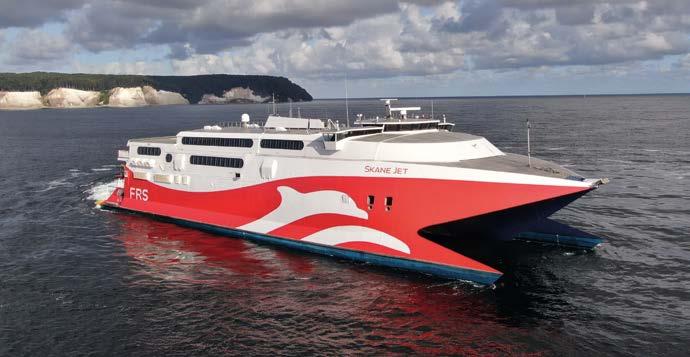
The new season begins in spring 2021. The ship is already good to go, as the winter break was used intensively for maintenance work. This naturally included checking all lubricants with the help of OELCHECK.


Travelling on the Skane Jet is an experience. The catamaran is 91 m long and 26 m wide and races across the Baltic Sea at speeds of up to 35 knots (64.82 km/h). It carries up to 676 passengers and 210 vehicles. To pass the time on board, you can visit restaurants, a shop, learn about the destinations or feel the airstream outside on the open deck.
A waterjet-driven catamaran
A classic propeller, commonly referred to as a screw propeller, is nowhere to be seen at the stern of the Skane Jet. It uses the principle of water jet propulsion. Its high speeds are provided by four drive units with jet propulsion. Four impellers (jacketed propellers) suck in water under the hull and blast it out again via jets at the stern. 18.5 m3
The impellers are driven via transmissions manufactured specifically by Renk AG for marine applications. They are powered by Ruston 20RK 270M MII four-stroke, high-speed marine diesel engines with a combined power output of 40,000 HP. The pressure ratios on the blades of the impellers are approximately comparable to those of a pump. This means the vibrations are lower than with a conventional propeller ship propulsion, and the ride experience is calmer. However, the jet's hull must be adapted to accommodate the water drive. Vessels with jet propulsion can generally be built particularly flat and are very manoeuvrable, even when travelling slowly.
Check-up
In times of Covid19, it becomes clear how effective a company’s risk management is. OELCHECK has overcome the ever-changing challenges well so far and has now taken a step towards normality. After strenuous months of shift work, we resumed normal operation on 22 March – albeit under strict conditions.
In order to eliminate the risk of infection as far as possible, our employees must not only observe social distancing and hygiene regulations, they must all also make use of the free FFP2 masks and selftests. The 4,500 selftests were procured on our own initiative. Implementation was far from straightforward, but was ultimately successful. Selftests several times a week are now mandatory for all employees in accordance with a specified schedule. The tests are painless and easy to do, and appropriate instruction has been given in advance. They are carried out at home shortly before leaving for work. After 15 minutes, the result becomes visible on a test card with a high level of accuracy (sensitivity 95%).
Only employees with a negative test result may enter our premises. On the morning of 22 March, the first checks were carried out before the start of normal operation. In each of our buildings, two employees have been specifically trained and appointed to checking the test cards and documenting the results..
Currently, we are working intensively on a rapid vaccination programme for our employees. We continue to do our utmost to provide our services and our customer service at the usual quality level, even under the difficult conditions of the pandemic. After all, OELCHECK is not only systemically important for the maintenance of power generation systems.
Sincerely,
 Barbara Weismann
Barbara Weismann
additives. The soot content and any impurities with fuel or water are examined particularly closely. 100 of a high-performance gear oil (ISO VG 100) with extreme pressure absorption and loadbearing capacity as well as excellent seal compatibility are used to lubricate the gears. However, the transmissions are in service on the high seas. Therefore, when evaluating the oil analyses, OELCHECK tribologists pay particular attention to any water ingress and contamination with sodium, which could originate from the salty seawater.
The speed of the jet is determined by the thrust force of the water jet drives, the direction of travel by the position of the "buckets". Their positioning is facilitated by a hydraulic system filled with a highpressure hydraulic fluid. It protects the hydraulic components and control devices from malfunctions or failures even at low temperatures. When selecting the fluid, the shipping company considered an important property in terms of water pollution control. According to the OECD test and the GHS criteria (Globally Harmonised System), the fluid is neither acutely nor chronically toxic. OELCHECK checks samples from the hydraulic system with regard to wear, purity (filtering) and water content and detects contamination, e.g. from seawater.
OELCHECK is the trendsetting laboratory for lubricant and fuel analyses in Europe. We constantly strive to achieve the highest possible level of customer satisfaction. However, this can only be achieved if we know the exact requirements of our customers. Your ideas, suggestions and criticism are important stimuli for our further development. We therefore conducted another large customer survey in December 2020. The response showed us the importance of this survey. We have received many specific suggestions and requests to improve and expand our services.
Here is a summary of the overall findings of the survey:
Laboratory reports and diagnoses are excellent
The participants’ verdict was clear: 97 % are very satisfied or satisfied with the laboratory reports and 85 % with the diagnoses.
Our consulting services are valued
The following were particularly well rated: Our expertise, speed and response to individual questions and queries about laboratory reports.
LAB.REPORT – as yet not known enough
The users of our customer portal are more than satisfied with its comprehensive functions. If you are not yet familiar with it, you can log in as a guest at www.lab.report and get an initial overview of the functions.
oelcheck.de – the information platform
Our frequently visited homepage provides comprehensive information about our services and about lubricants as well as their analysis.
Our app – belongs in the spotlight
The free OELCHECK 4.0 app has proven itself in practice, but is still underused. Give the app a try: It is simple, innovative, fast and digital.
OELCHECKER – a popular read
Most of the participants read our customer magazine regularly. Topics such as general lubrication knowledge, test procedures and practical reports are read frequently.
Perfect price-performance ratio! Customers are always particularly critical when it comes to costs. However, the majority of participants is of the opinion that OELCHECK‘s priceperformance ratio is perfect.
Conclusion
We are not only delighted with the honest and positive results of our customer survey, we are also dutybound to maintain standards and to constantly optimize our services for you.
A big thank you to all participants for answering our questions and for the many suggestions!
Further expansion of OELCHECK laboratory
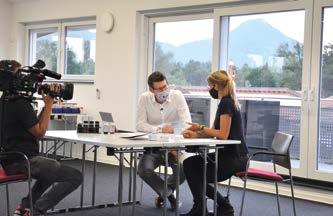
and national safety regulations for seagoing vessels. Employees are expertly trained and the procedures on board and on land are perfectly organized. The maintenance condition of the company’s modern ships is state ofthe art. Inspection and maintenance measures are continuously carried out.
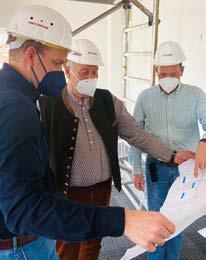
Less sulphur, particulate matter and soot
The shipping company only uses marine diesel (MDO) with a sulphur content of less than 0.1 % for the „Skane Jet“. This marine diesel is similar to conventional diesel fuel, but has a higher viscosity and density. It corresponds to the sulphur emission limit value required for operation in EU ports and ECAs (Emission Control Areas). In addition, the marine diesel releases significantly less particulate matter and soot during its combustion process than ship fuels with high proportions of heavy oil and sulphur.
Perfect maintenance –oil analyses included
The safety of passengers and crew is of utmost importance at FRS Baltic GmbH. All safety measures comply with the requirements of the international
The "Skane Jet" winter break is used to carry out comprehensive maintenance. OELCHECK lubricant analyses are an indispensable component of this. The oils in the engines and their connected transmissions are examined. Not to mention the fluids from the hydraulic systems, which ensure the position of the water outlet jets as well as the capstans, the ship's mooring winches.
The four Ruston four-stroke diesel engines are each filled with approx. 1,200 of SAE 40 engine oil, which has proven its worth in highspeed marine engines. It is particularly thermally and oxidatively stable and protects against wear, corrosion and deposits. It also has excellent water separation characteristics. When analyzing the oils, OELCHECK examines the oil condition, checks for signs of wear, possible impurities and the condition of the
The winter break provides an opportunity for comprehensive maintenance of the "Skane Jet" in the town harbour of Sassnitz. However, checks and maintenance work are also carried out continuously throughout the season. The crew monitors all systems and checks compliance with all operating parameters. Lubricant samples from engines, gears and hydraulics are examined every three months by OELCHECK.
Like FRS Baltic GmbH, many shipping companies and operators of port facilities use OELCHECK lubricant analyses. Ships used to construct offshore wind turbines, the Arctic research ship Polarstern or the container terminals in the ports of Hamburg and Rotterdam also have one thing in common: The lubricants in their systems are monitored by OELCHECK lubricant analyses.
FRS – Ferry connections worldwide
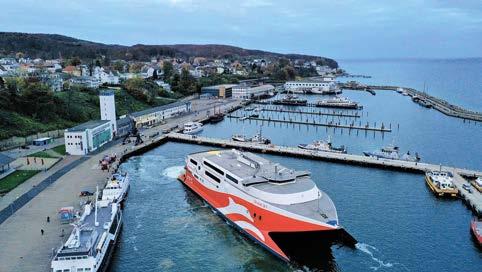
FRS Baltic GmbH is a company of FRS GmbH & Co. KG, which looks back on over 150 years of marine history. FRS has evolved from a regional passenger shipping company into an internationally active group of companies and is now one of Europe's leading specialist ferry operators. FRS operates 72 ships and has more than 2,000 employees worldwide. The shipping company has headquarters in Flensburg and operates numerous national and international ferry and catamaran connections, transporting around 7.9 million passengers and 2.1 million vehicles per year. FRS is also active in the areas of offshore logistics, port management, crewing and maritime management consulting.
For further information, visit: www.frs.world
Although the pandemic had caused delays, the new OELCHECK building at Kerschelweg 18 has long been a hive of activity. At approximately 2,000 m², it is the largest of our three buildings. The management as well as the Service and Sales, Tribology, Agent Support and Accounting departments have already moved into the new premises. The move freed up an additional 350 m² in the original OELCHECK building. This space is urgently needed for further expansion of the laboratory, as our company continues to grow dynamically not only
in terms of the number of employees, but also in terms of the amount of laboratory equipment. The additional area is on the upper floor, directly above existing laboratory rooms. We are working intensively on the extension. The carpet will be replaced by laboratory-grade PVC flooring, additional ventilation is being installed, doors are being converted, and a laboratory washroom with solvent disposal is being installed. Almost everything is being replaced. In summer 2021, the laboratory equipment will then be relocated and new equip
ment procured. When the new laboratory area is commissioned, the oil samples can also be transported via a lift. They will be transported from the unpacking room on the ground floor to the upper floor and back down again via their own lifting platform.
Filming with Laura Kukuk
What added value do OELCHECK’s all-inclusive analysis kits offer when preparing reports for vintage cars?
This question was the focus of a video produced on behalf of OCC vintage car insurance and in cooperation with OELCHECK.
Classic car expert Laura Kukuk , wellknown from the media, talked us through the film. She was supported by Stefan Mitterer, OELCHECK’s Managing Director for Technical Service & Sales. The automotive engineer (B. Eng.) travels the world as a vehicle and classic car expert. She examines racing, sports and classic cars. OELCHECK analyses are often used for this purpose. In particular, analyses are carried out on vehicle components
such as the engine, transmission and differential in order to obtain a better overview of their condition.
Of course, one thing was essential for the filming: A lubricant sample that she brought with her. This went to the laboratory, together with the questions: Why does an oil analysis make sense? And how is such a sample analyzed? In the laboratory, Stefan Mitterer discussed the individual test methods such as infrared spectroscopy, kinematic viscosity, IR index, element analysis and gas chromatography in more detail. He explained what conclusions can be drawn from the results on the condition of the lubricant and on the early detection of damage or wear.
Stefan Mitterer not only provided the film team with an insight into the company and into the world of
lubricant analysis, but also supported the evaluation of the laboratory report with his expertise. Laura Kukuk commented in conclusion, "That’s why we love your reports!"
The final video is available on the OELCHECK VIMEO video page.
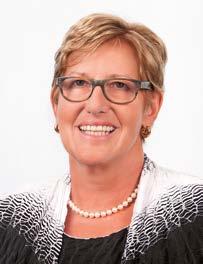
OELCHECK
OELCHECK App 4.0 with new feature Simple. Innovative. Fast. Digital. Gear oil in continuous operation
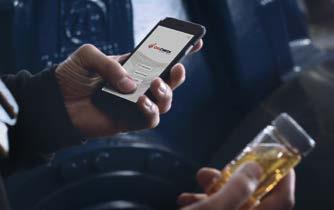
An extra feature has been added to the OELCHECK App 4.0: Direct machine search is now possible –even without a QR code. This means that the user can now enter the sample data in two different ways, either by scanning the QR code or by directly searching for the machine.
How does the new feature work?
The "machine search" function displays all machines whose operating materials have already been examined by OELCHECK. The customer can quickly and easily select the desired machine. Data entry is also easy in offline mode – the OELCHECK App 4.0 automatically synchronizes the data in online mode. The OELCHECK App 4.0 helps users to receive their laboratory report simply, innovatively, quickly and digitally.
For more benefits and information, watch our new app video. This is available on the OELCHECK VIMEO channel.
OELCHECK App 4.0 offers the easiest way to enter sample data. Customer-specific information as well as details of the individual machines are saved once and are then always available. Customers simply add the data from the respective sample.
 A
A
project
by VEKA AG and HansWeber Maschinenfabrik GmbH
VEKA AG’s plastic window profiles are among the most popular in the world. VEKA AG produces the majority of these with Weber extruders. In 2014, the two companies began a field trial on how long the gear oil can be used in a twin-screw extruder. OELCHECK lubricant analyses were part of the project right from the outset. In the meantime, the oil has already completed more than 40,000 operating hours without abnormalities and an oil change is not yet necessary.
40,000 operating hours – 28 oil analyses
Use of the app is part of our range of services and is free of charge. Available for Android and iOS in German and English.
OilDoc Conference & Exhibition
November 17-19, 2021 – hybrid event concept
Special times require special measures:
True to this motto, the OilDoc Conference & Exhibition will take place as a hybrid event this year.
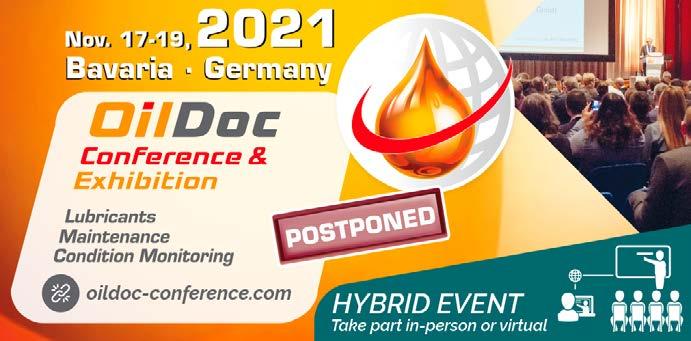
In this way, participants can decide for themselves whether they would like to be there live at the KU'KO Culture and Congress Centre in Rosenheim or participate online directly from their workplace in Europe's pioneering event on the topics of lubrication, maintenance and condition monitoring. The conference – consisting of a specialized exhibition, special networking events and top class presentations – is in any case the ideal platform to meet leading personalities from research and development, experienced technicians and experts in the efficient use of lubricants. Distributed across three halls, there will be over 70 hand selected specialist lectures from renowned speakers during the two day event – also streamed live for virtual participants.
The speakers include OELCHECK employees who will be presenting new scientific findings and communicating current trends for daytoday lubrication challenges:
Our presentations at the conference:
A new method for oxidation detection in industrial oils
Sina Malenke, Scientific Team Assistance
Digitalization & lubricant analyses – an efficient partnership
Stefan Mitterer, Managing Director Technical Service & Sales
Monitoring of antioxidant depletion by FT-IR
Dr. Thomas Fischer, Scientific Director
Insight into coolant analysis – methods and developments
Dr. Christoph Heinzl, Deputy Scientific Director
How to extend oil service life in commercial vehicle diesel engines when using B100 (FAME)
Carsten Heine, Technical Support Manager
www.oildoc-conference.com
Hans Weber Maschinenfabrik GmbH has been synonymous with perfection in mechanical engineering for almost 100 years and provides customers from over 60 countries with impressive high quality grinding and extrusion products. Over 20,000 machines are in use around the world. Most of their components are produced at the company’s headquarters in Kronach, Upper Franconia. For around 50 years, VEKA AG has been using Weber extruders to manufacture plastic profiles for windows and doors.
The two familyowned companies share not only a longstanding partnership, but also high standards of quality, innovation and reliability. These go hand in hand with futureoriented and sustainable action. This requires openness to change and to alternative ideas, especially in maintenance. Up to now, VEKA AG maintenance personnel have changed the gear oil on Weber extruders after 6,000 operating hours or one year. This means that they are always on the safe side, but if a large number of systems are in operation, the costs for the maintenance time and the purchase of the new oils increase. In order to reduce costs while saving fresh oil resources, the two companies began a joint field trial.
A Weber DS 11 twin-screw extruder
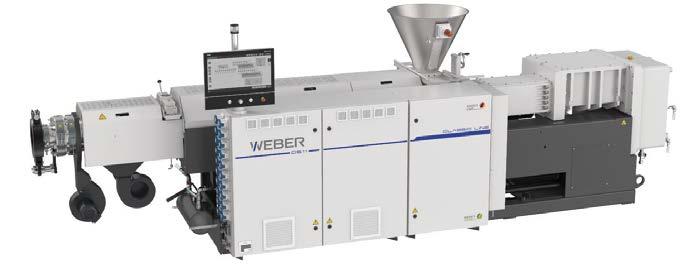
A mineral oil-based ISO-VG 460 industrial gear oil of type CLP was tested. It was installed in the transmission of a Weber DS11 twinscrew extruder. VEKA AG uses it to manufacture window profiles in Sendenhorst in Münsterland. It is here that the company’s headquarters and centre of excellence are located.
In extrusion, thermoplastically deformable plastic is pressed through a shaping aperture under high pressure as a tough mass at a temperature of approx. 190°C. In a twinscrew extruder, two worm shafts are placed in a heated cylinder. These rotate by means of an upstream transmission and intertwine. They move the tempered raw material forwards. At the same time, the movement generates energy, which causes an additional temperature increase and causes the plastic to melt.
The performance of the transmission is not only essential for the melting process, it must also cope with high torques with relatively low axial spacing and withstand the axial forces from the extrusion process. This in turn results in the requirements for the industrial gear oil used. It should have a high pressure absorption capacity, excellent wear protection and very good resistance to ageing.
VEKA – first-class condition monitoring
From the outset, the industrial transmission oil was regularly monitored and all values and activities documented. The temperature of the gear oil is continuously checked. It should not exceed 65°C. To ensure the correct temperature at all times, VEKA AG employees regularly maintain the transmission's cooling system, among other things. They also check the bleed screws and their filters for cleanliness and functionality. This allows warm air to escape instead of forming condensate. And the clean filters prevent any impurities from entering the oil circuit.
The trial began at the end of 2014 and with it a long series of OELCHECK lubricant analyses. Since the ageing of the oil plays a decisive role in its use, allinclusive analysis kits 2 are used with additional determination of AN/NZ. The AN (acid number) or NZ (neutralisation number) is a measure of the degree of oil acidification. By comparison with the fresh oil values, the AN allows conclusions to be drawn regarding the oxidation of the oil and the breakdown of oil additives, making it a valuable addition to infrared spectroscopy, which determines oxidation in A/cm.
The oil samples are taken at regular intervals via a drain tap specially installed on the system. Data is recorded and transmitted to OELCHECK via a QR code and app. The laboratory reports are jointly reviewed by employees of VEKA AG and Hans Weber Maschinenfabrik GmbH.
To date, the gear oil has reached a running time of over 40,000 operating hours, which have now been monitored by 28 oil analyses. The current laboratory report shows: All values are still in the green range! Even the typical wear values for copper, tin and lead coming from the bearings or bearing cages are noncritical. Contaminant levels, such as from silicon, are minimal. The viscosity and oxidation, synonymous with oil ageing, and the AN/NZ value have not yet reached their limits. The gear oil condition as a whole allows further operation of the gear oil.
Conclusion:
Condition-dependent oil changes
So far VEKA AG has replaced the gear oils of the extruders after 6,000 operating hours or one year. Assuming regular OELCHECK oil analyses, the oil changes are now carried out for all systems that are similar to the Weber DS 11 twinscrew extruder, depending on the oil condition. The trial continues, but its objective has already been achieved. Thanks to condition dependent oil changes, the costs of fresh oil and labour have been reduced. OELCHECK lubricant analyses ensure the necessary safety of operation.
Relative humidity at defined temperature and water saturation curve
OELCHECK now determines the relative humidity of oils at defined temperatures and also creates water saturation curves! This provides additional valuable information for proactive maintenance. Appropriate oil maintenance measures or oil changes can now be carried out even earlier and, above all, large hydraulic systems and circulation systems can be protected against malfunctions caused by free water.
Oils used for lubrication, pressure transmission or insulation should contain as little water as possible. But fresh oils always contain a small proportion of water. This water is dissolved in the oil. The proportion depends mainly on the base oil type and the additive. The relative humidity percentage indicates the concentration of water dissolved in the oil. Depending on the temperature, the oil cannot "carry" any more water if the concentration is above 100% relative humidity or if the water saturation point is reached. At this point, fine water droplets usually form and the oil becomes cloudy. If the proportion of these droplets is too high, free water settles in the form of a clearly visible phase separation, particularly during the cooling process. At a relative humidity of over 100 %, abrasive wear can occur at moving friction points. Where water is deposited instead of oil, the extremities of the surfaces are no longer lubricated. Water can cause massive corrosion and rust formation.
OELCHECK uses the Karl Fischer method to measure all the water present in the oil, i.e. dissolved and free amounts, in ppm. This absolute water content does not indicate the relative humidity and thus not how much water is dissolved in the oil or how much water the oil could absorb before it separates. But knowing the relative humidity relative to the total water present in ppm is particularly important for oil fills in large hydraulic systems, in transformers or in circulation systems where water poses a risk, such as the paper industry or cold rolling mills, but also in systems with condensation.
Relative humidity is variable
The relative humidity depends on the base oil type, viscosity and additives in the oil. It also changes depending on temperature, oil ageing and humidity. Oils dissolve significantly less water at low temperatures than at high temperatures. As an oil cools down, it releases more water than at its previous operating temperature. As the temperature changes, so does the water saturation point of an oil.
OELCHECK closes the knowledge gap
Modern lubricants age differently
Oxidation index clearly shows the ageing behaviour
In many systems, online sensors continuously measure the relative humidity and temperature of the oil. However, their measurements do not predict how the relative humidity and saturation limit react when temperatures change or even how high the total water content is. But it is precisely this knowledge that is important so that appropriate measures can be taken in good time, in order to protect the systems from malfunctions caused by free water.
OELCHECK provides a remedy and now offers two additional and completely new extra tests:
Determination of the relative humidity in % at specified temperatures between 30 and 80 °C.
Calculation of the water saturation curve in the range of 30 to 80 °C.
The creation of a water saturation curve requires the determination of the absolute water content in ppm using the Karl Fischer method. Water saturation is determined analogously with this value and from the relative humidity measured at a wide range of temperatures. On this basis, OELCHECK creates the corresponding water saturation curve, a new maintenance tool.
If the absolute water content (at a particular temperature) is below the water saturation curve, the water is dissolved in the oil.
If the water content (at a particular temperature) is above the curve, it can be assumed that the oil is cloudy or free of water, because the oil is already fully saturated with water.
A practical example: The oil circulation system of a paper machine is filled with 5,000 litres of CLP 100. The typical water saturation in such a system is usually approx. 90%.
The laboratory analysis at 25 °C shows a clear oil, but some water droplets have settled in the container. The Karl Fischer method determines an absolute water content of 284 ppm.
At the time of sampling at 45 °C, a water content of 425 ppm can be calculated from the water saturation diagram.
At an operating temperature in the oil tank of 70 °C, the oil is transparent, although the water content determined on the basis of the water saturation curve is assumed to be 927 ppm at 90% saturation.
This means that when the oil cools down from 70 °C to 25 °C, 643 ppm of free water can separate from the oil.
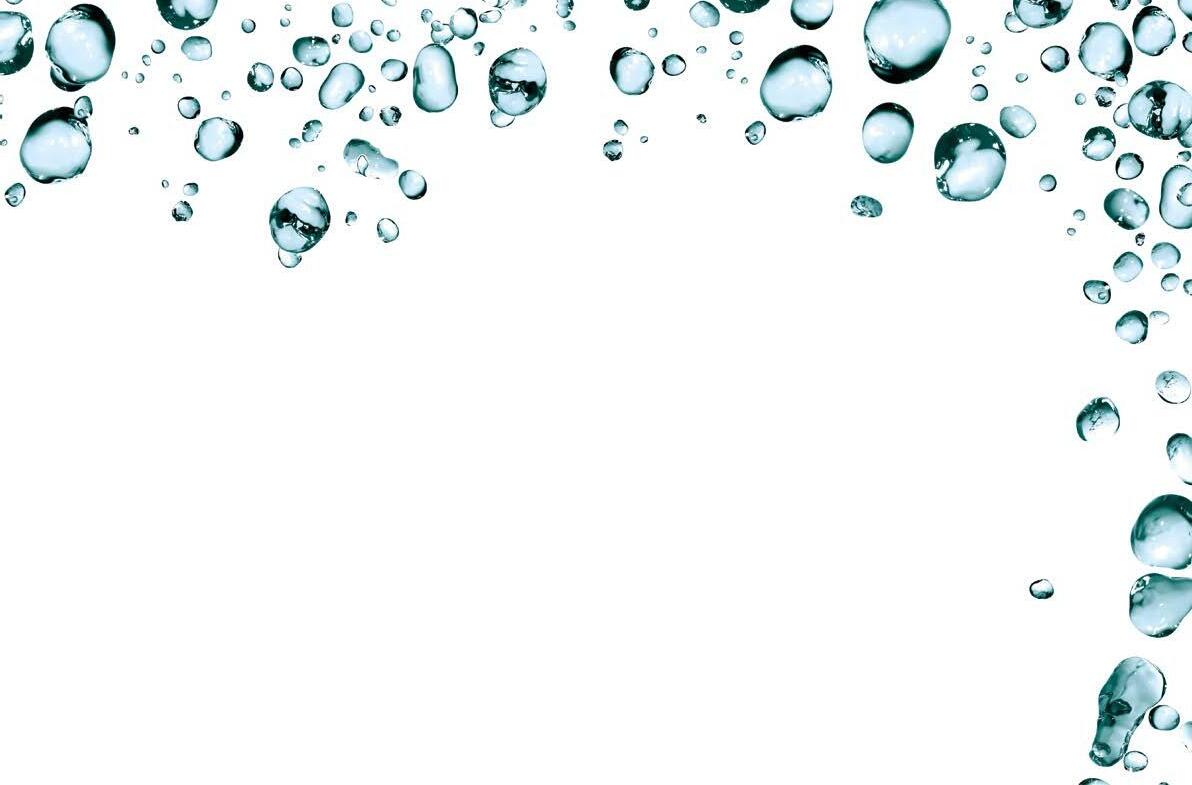
For the 5,000 litres in the paper machine, this would mean that approximately three litres of free water could separate from the oil during the cooling phase from 70 °C to 25 °C. This free water should be continuously removed during the cooling phase. Without knowledge of the water saturation curve, it would not be possible to calculate or estimate the released water content.
Conclusion
With the new water saturation curve, proactive maintenance with water removal methods can take counteractive measures sooner – before the water saturation limit of an oil is exceeded and water is released at standstill. Using the saturation process, checking the oil fill depending on the temperature is significantly simplified. It becomes clear whether oil maintenance measures, drying or even an oil change are necessary or whether, for example, the oil should not fall below certain standstill temperatures..
Every lubricant ages over the course of its service life. The extent to which an ageing process has progressed is shown in the laboratory report in particular by the "oxidation" data. Among other analytical values, the oxidation value allows conclusions to be drawn about the remaining operating time of the oil. Oxidation is determined by IR spectroscopy in accordance with DIN 51453. This is done by passing infrared light through an oil-filled cell. The decrease in light intensity is measured as absorption. This method has already been defined at times when often simply refined mineral oils were used as base oils. Nowadays, for higher grade Group II or III oils or for partially synthetic or fully synthetic base products, oxidation can often no longer be determined with the relatively simple method, which is only defined for a certain "wave number".
OELCHECK has therefore further developed the method for detecting oxidation. Below the "oxidation" value, which is stated in absorption/cm oil layer thickness (A/cm), modern oils have recently also been given the dimensionless "oxidation index" in the laboratory report. While for oxidation in A/cm at a specific point in the graph, at a "band" at a wave number of 1710 cm1, the change in length compared to the base spectrum is calculated in cm, the index is based on an area calculation. In a differential spectrum, the oxidation index therefore not only looks at the change in length of a single peak, but also determines a change in area that can be calculated in a range between two wave numbers in which oxidative changes occur. The number listed in the laboratory report under "Oxidation Index" essentially corresponds to the increase in this oxidation area in cm². OELCHECK tribologists determined the left and right wave numbers and thus the calculation range for the oxidation index, depending on different oils or their intended use. Thanks to the oxidation index defined in this way, in contrast to the pure DIN line calculation in A/cm, the oxidation of modern lubricants can also be detected at a very early stage. The oxidation index thus provides reliable information for an upcoming oil change.
Oxidation in A/cm
As mineral oils age, oxygen molecule chains form double bonds to certain hydrocarbon compounds in the oils and form new molecular chains. When infrared light passes through these molecular chains, this light is absorbed more readily than in fresh oil. By subtracting the used and fresh oil spectrum, the oxidation is indicated in the laboratory report as "absorption of the IR radiation" in (A/cm), which refers to a path length of one centimetre (oil layer thickness) of the measuring cell.
A standard reaches its limits
When determining oxidation using IR spectroscopy in accordance with DIN 51453, it is assumed that a clear peak can be seen in the IR spectrum of an oxidized oil at a wave number of 1,710 cm1, which is influenced by the oxygen double bonds. This wave number was therefore used as the basis for the oxidation determination of mineral oil based used oils from engines and industrial lubricants.
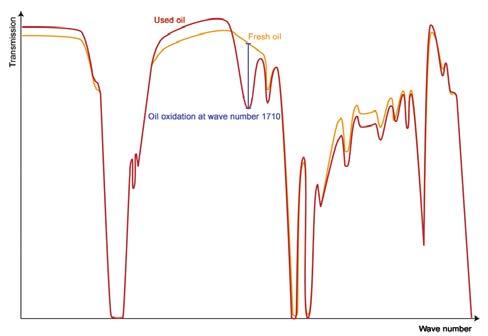
In today’s lubricants, which use better refined or partly synthetic base oils or modern additive technologies, however, the peakbased approach no longer provides sufficiently interpretable findings. Even in trend analyses over several 10,000 hour periods, OELCHECK tribologists are increasingly confronted with oxidation values that hardly change, although changes in viscosity, acids or oxidation inhibitors indicate an increasing ageing of the lubricant.
Many of the newer lubricants contain synthetic base oils
based on esters. In these oils, not only do the wear protection additives have a better effect, they are also more temperaturestable and age less. These synthetic long term oils are particularly advantageous for oils in systems where oil changes are complex and expensive, or which run at high temperatures. In oil analyses, however, it is detrimental that oxidation can no longer be detected because the ester components in the IR spectrum overlap precisely in the area with the oxygen double bonds in which oxidation is calculated according to the DIN method. Oxidation also cannot be calculated for lubricants that contain viscosity index improvers (VI improvers) or special additives that already have a clear peak area at 1,710 cm1 in fresh oil. For modern lubricants, the specification of oxidation according to DIN 51453 is in many cases extremely inaccurate; for oils with ester components, oxidation according to DIN cannot be specified. To ensure that accurate information on oil ageing is also possible for lubricants for which DIN oxidation cannot be determined, OELCHECK tribologists have taken into account the increase in viscosity, the reduction in additive content, the degradation of antioxidants as well as the increase in AN (acid
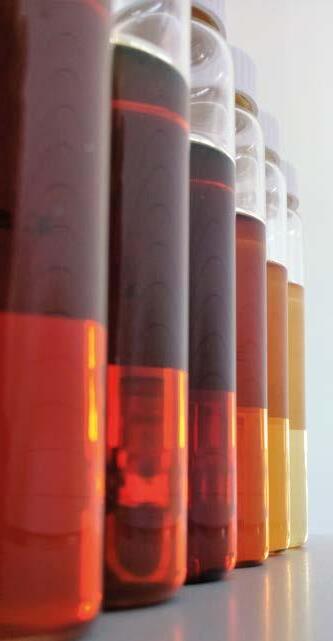
number) and, in the case of motor oils, the decrease in BN (base number).
Oxidation index – more meaningful as it is surface-based
Because the proportion of lubricants for which line-based IR oxidation determination was no longer reliable or impossible increased, OELCHECK tribologists provided the solution. After comparing various inspection and test procedures with differently aged oils from a wide range of applications, as well as after intensive discussions with lubricant and machine manufacturers, the solution is definite: IR spectroscopy is also used for the new oxidation index. But instead of only looking at the change in length defined in DIN at the peak oxidation of 1,710, the focus for the oxidation index is on the range of the IR spectrum between 1,500 and 1,700 cm1 With this areabased calculation method, the lateral limits can be defined depending on the oil type, so that they always reflect the change caused by oxidation. This means that any influences or overlays caused by lubricant components such as ester compounds, oxidation inhibitors or VI improvers can be eliminated.
Here is an example of this: The performance of the areabased oxidation index is exemplary when considering a synthetic gear oil from a wind turbine: Mineral gear oil was used until 2016. In July 2016, an oxidation of 3 A/cm was clearly determined for this. However, after switching to the synthetic product, the conventional method could no longer determine a meaningful oxidation value.
In the IR spectrum from February 2021 (see bottom right), one peak overlaps the other at a wave number of 1,710 cm1. Any oxidation of the oil is not perceptible.
SPRING 2021
OELCHECKER – a magazine of OELCHECK GmbH Kerschelweg 28 · 83098 Brannenburg · Germany
info@oelcheck.de · www.oelcheck.de

All rights reserved. Reproduction only upon approval!
Concept and text: OELCHECK GmbH · Astrid Hackländer
Typesetting and design: Agentur Segel Setzen, Petra Bots, www.segelsetzen.com
Photos: FRS Baltic GmbH · Hans Weber Masch. GmbH · OELCHECK

OXIDATION INDEX – ADVANTAGES AT A GLANCE
The method newly developed by OELCHECK for the oxidation index based on IR spectra:
provides meaningful values for oil oxidation of synthetic lubricants shows oxidative changes at a very early stage is a reliable decision-making aid for an oil change based on the limits defined by OELCHECK
creates significantly higher security for operators in trend monitoring
clearly shows influences of stress or temperature changes
enables reliable prognosis for progressive oil oxidation
is an important indicator for early detection of problems in connection with changes in wear, viscosity and additives
recommends additional investigation to determine the causes of changes
serves as a decisionmaking aid for measures to reduce temperature or stress on site.
However, if the last three IR spectra are subsequently considered areabased, the oxidation index provides a much more differentiated picture of oil oxidation.
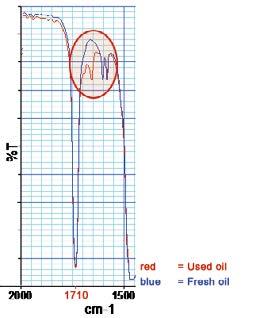
Oxidation index – now in use
OELCHECK now determines the oxidation index for certain synthetic gear oils, for some turbine oils and for fluids from stationary hydraulic systems for which complex additive compounds or biologically faster degradable components are used. Wider uses for other applications and special oil types are already under preparation.
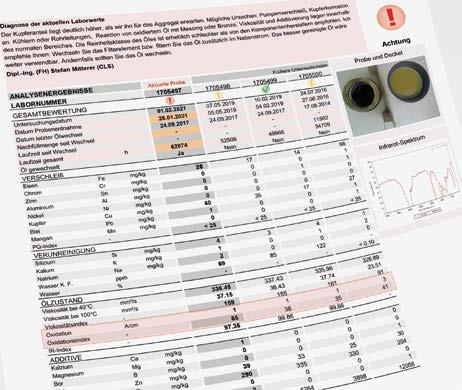
The beginning ageing process of the oil would have already been discovered with the oxidation index in February 2019.
Long before this, an even stronger PAI (Peak Area Increase) = 65 cm² increase in the IR spectrum was observed in February 2021 between the two wave number limits defined for this oil type by OELCHECK.
Since the new area based method determines relatively high results for the oxidation index in addition to changeable wave number limits, the limit values defined for oxidation according to DIN in A/cm cannot be used for evaluation. OELCHECK therefore defined its own limit values for the "green-yellow-red" rating of the oxidation index.
All laboratory reports that include an additional value for the oxidation index still include the value for oxidation according to DIN. Finally, many machine and lubricant manufacturers still use oxidation limits defined by IR spectroscopy in accordance with DIN.
Do you have any questions about the oxidation index?
Stefan Mitterer, Managing Director of Technical Service & Sales and Dr. Christoph Rohbogner and his tribologist team will be happy to advise you!

